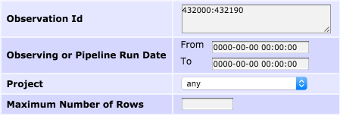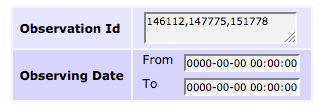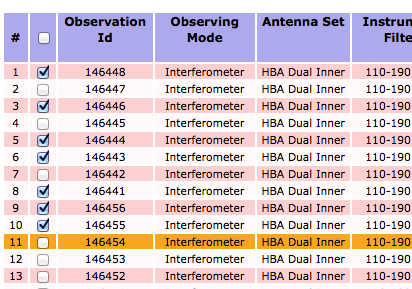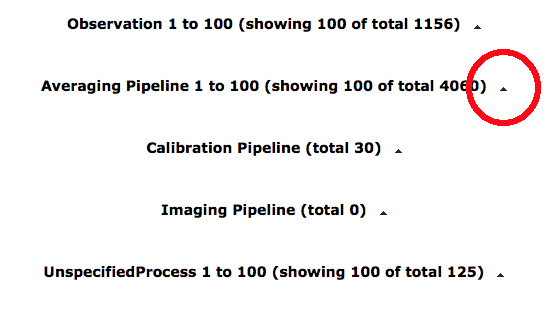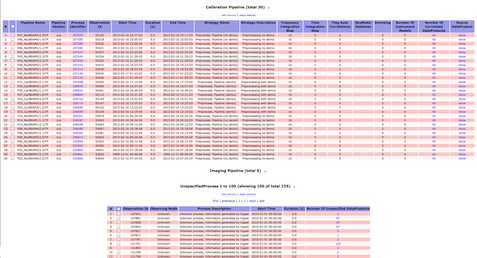This is an old revision of the document!
Advanced ways to find and retrieve data in the LTA
There are some useful ways to find and retrieve your data in the LTA that might not be immediately obvious. This page explains some of the more advanced options you have.
Queries
- You can use colons in numeric queries, to select ranges. This will for example give all observations and pipelines that have a SAS/Observation ID in the range from 432000 to 432190:
In textual entries, wildcards can be used.

- You can put a list of SAS/Observation IDs in the query:
Viewing data
When you are looking at the results of a query you might see something like this:
This means that the observation is known in the LTA, it knows what data was produced, the produced data was not archived, but further processing happened on the raw data and the results of some of those pipelines were archived. If you click on the zero, you will see something like this:
This allows you to navigate from a pipeline back to the original observation, or from the observation to any pipelines that have run on the raw data.
Retrieving data
- You can retrieve data on the Observation and Pipeline level, you don't have to select all files individually.
- If you have a query with more than 1000 results, you can open the multiple pages each in a separate tab/window.
- With the small triangle next to a list, you can fold or unfold the list to get a better overview.
Folded entries
Unfolded entries
DBView
There is a server that gives the option to run your own queries on the database http://lofar-dbview.target.rug.nl/
A useful query might be this one, that gives you all files for a certain Obs Id (SAS VIC tree ID).
SELECT fo.URI, dp."dataProductType", dp."dataProductIdentifier",
dp."processIdentifier"
FROM AWOPER."DataProduct+" dp,
AWOPER.FileObject fo,
AWOPER."Process+" pr
WHERE dp."processIdentifier" = pr."processIdentifier"
AND pr."observationId" = '123456'
AND fo.data_object = dp."object_id"
AND dp."isValid" > 0
In this '123456' should be replaced with the Obs Id of an Observation/Pipeline you're looking for.
AstroWise Python Interface
There is also a python interface to the LTA. With this, you can script some advanced queries. To have this working, you first need to install the LTA client in your machine. Once you have installed the client, set up your user name and password. These are the same as for MoM. Remember that this is just a different interface to the LTA catalogue: you will need the same credentials as for the web interface.
After installing the LTA client, add the following to the file .awe/Environment.cfg in your home directory
database_user : <your username> database_password : <your password>
then create the variable awetarget and set it to awlofar. In a bash shell, you can do so by adding the following to your .profile file:
export AWETARGET=awlofar
Finally, your hostname may cause an error, if it does not contain a full domain. In this case, check your /etc/hosts file. You should find a line that looks like this
127.0.0.1 localhost
Change that line into
127.0.0.1 localhost <your_host_name>
If you do not know your hostname, just type hostname in a shell and you will get it as an output.
Now, you can use the following script as a test. It may still give you some warnings, but if it prints out a list of pointings, then you are ready to go. You may need to kill the script, because it will print out all the observations in a certain patch of the sky archived in the LTA.
# python code
from pprint import pprint
from common.database.Context import context
from awlofar.main.aweimports import Observation, Pointing, SubArrayPointing
result = {}
for project in sorted(context.get_projects()) :
print "Project %(project)s" % vars()
ok = context.set_project(project)
# do your query
obs_ids = set()
query = (Pointing.rightAscension > 95) & \
(Pointing.rightAscension < 105) & \
(Pointing.declination > 20) & \
(Pointing.declination < 30)
print "Total Pointings %d" % len(query)
for pointing in query :
print "Pointing found RA %f DEC %f" % (pointing.rightAscension, pointing.declination)
query_subarr = SubArrayPointing.pointing == pointing
for subarr in query_subarr:
query_obs = Observation.subArrayPointings.contains(subarr)
for obs in query_obs :
obs_ids.add(obs.observationId)
result[project] = sorted(list(obs_ids))
print result[project]
pprint(result)
If you get errors and do not manage to retrieve the list of pointings, there may be the need to open some port on the firewall at your institution. Specifically, port 1521 should be open. In case of trouble, get in contact with Science Support.
Once you have tested that your connection to the catalogue is working, you are ready to browse the archive and stage the data you need. Here we will list a few examples of python scripts that can be used to access the LTA. All of them will need to import some modules:
from datetime import datetime
from awlofar.database.Context import context
from awlofar.main.aweimports import CorrelatedDataProduct, \
FileObject, \
Observation
from awlofar.toolbox.LtaStager import LtaStager, LtaStagerError
The lines above must be added to each of the scripts below for these to work.
This simple script will allow you to find and stage all data within a single project LCX_YYY.
do_stage = True
project = 'LCX_YYY'
cls = CorrelatedDataProduct
if not context.set_project(project) :
raise Exception("You are not member of project %s" % project)
query_observations = Observation.select_all().project_only()
uris = set() # All URIS to stage
for observation in query_observations :
print("Querying ObservationID %s" % observation.observationId)
# Instead of querying on the Observations of the DataProduct, all DataProducts could have been queried
dataproduct_query = cls.observations.contains(observation)
# isValid = 1 means there should be an associated URI
dataproduct_query &= cls.isValid == 1
for dataproduct in dataproduct_query :
# This DataProduct should have an associated URL
fileobject = ((FileObject.data_object == dataproduct) & (FileObject.isValid > 0)).max('creation_date')
if fileobject :
print("URI found %s" % fileobject.URI)
uris.add(fileobject.URI)
else :
print("No URI found for %s with dataProductIdentifier %d" % (dataproduct.__class__.__name__, dataproduct.dataProductIdentifier))
print("Total URI's found %d" % len(uris))
if do_stage :
stager = LtaStager()
stager.stage_uris(uris)
The following will find and stage subbands 301 and 302 for all targets within two different projects.
do_stage = False
project1 = 'LCX_YYY'
project2 = 'LCZ_VVV'
subband1 = 301
subband2 = 302
cls = CorrelatedDataProduct
# All URIS to stage
uris = {
project1: set(),
project2: set(),
}
for project in (project1, project2) :
print("Using project %s" % project)
if not context.set_project(project) :
raise Exception("You are not member of project %s" % project)
query_observations = Observation.select_all().project_only()
for observation in query_observations :
print("Querying ObservationID %s" % observation.observationId)
dataproduct_query = cls.observations.contains(observation)
# isValid = 1 means there should be an associated URI
dataproduct_query &= cls.isValid == 1
dataproduct_query &= ((cls.subband == subband1) | (cls.subband == subband2))
# Or for stationSubband do :
#dataproduct_query &= ((cls.stationSubband == subband1) | (cls.stationSubband == subband2))
for dataproduct in dataproduct_query :
# This DataProduct should have an associated URL
fileobject = ((FileObject.data_object == dataproduct) & (FileObject.isValid > 0)).max('creation_date')
if fileobject :
print("URI found %s" % fileobject.URI)
uris[project].add(fileobject.URI)
else :
print("No URI found for %s with dataProductIdentifier %d" % (dataproduct.__class__.__name__, dataproduct.dataProductIdentifier))
for project in (project1, project2) :
print("Total URI's found for project %s: %d" % (project, len(uris[project])))
stager = LtaStager()
for project in (project1, project2) :
if do_stage :
stager.stage_uris(uris[project])
Here, we find and stage data between freq1 and freq2 taken within one project between day1 and day2
do_stage = True
project = 'LCX_YYY'
freq1 = 172.0
freq2 = 178.0
day1 = datetime(2016,1,20) # this could include time; ie hours, minutes, secondes
day2 = datetime(2016,1,31) # idem
# DataProduct class to query; CorrelatedDataProduct, SkyImageDataProduct, etc ...
cls = CorrelatedDataProduct
if not context.set_project(project) :
raise Exception("You are not member of project %s" % project)
query_observations = ((Observation.startTime >= day1) &
(Observation.endTime < day2)).project_only()
uris = set()
for observation in query_observations :
print("Querying ObservationID %s" % observation.observationId)
dataproduct_query = cls.observations.contains(observation)
# isValid = 1 means there should be an associated URI
dataproduct_query &= cls.isValid == 1
dataproduct_query &= cls.minimumFrequency >= freq1
dataproduct_query &= cls.maximumFrequency < freq2
for dataproduct in dataproduct_query :
# This DataProduct should have an associated URL
fileobject = ((FileObject.data_object == dataproduct) & (FileObject.isValid > 0)).max('creation_date')
if fileobject :
print("URI found %s" % fileobject.URI)
uris.add(fileobject.URI)
else :
print("No URI found for %s with dataProductIdentifier %d" % (dataproduct.__class__.__name__, dataproduct.dataProductIdentifier))
print("Total URI's found %d" % len(uris))
if do_stage :
stager = LtaStager()
stager.stage_uris(uris)
